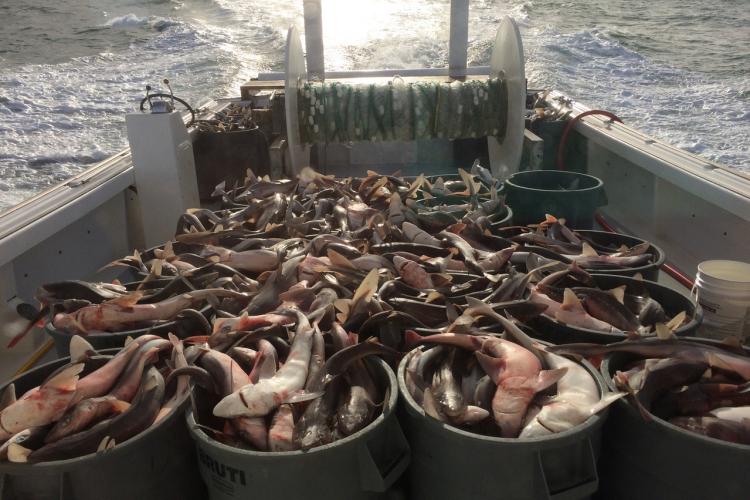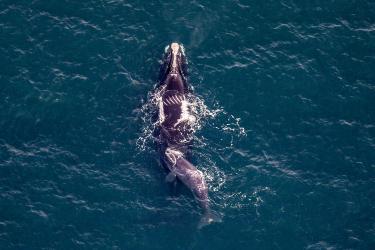Hi y’all! I’m Denise Craft from Virginia Beach, Virginia. I have a bachelor’s degree in biology from Old Dominion University. I started observing in September 2002 (so old school!). I had gotten laid off from an office job after the September 11 terrorist attacks. I was excited to find a job where I could use my biology degree to work at sea. I was certified for a lot of fisheries gear, including beach seines, purse seines, pair trawls, longlines, otter trawls, scallop trawls, and scallop dredges. I’ve deployed on fishing vessels from Portland, Maine, to Beaufort, North Carolina. Today, I’m only certified for fisheries using gillnets and I mostly observe out of Virginia Beach, because I have twins. These days, a typical day at sea is going out on a single-day gillnet trip targeting species such as spiny dogfish, monkfish, Atlantic croaker, spot, southern kingfish, or striped bass.
My favorite trip or gear was the beach seine fishery in North Carolina! In the small town of Corolla on the Outer Banks of North Carolina, fishermen would go fishing for striped bass. They pull the nets onto the beach with their trucks. It’s such a unique fishery! It was fun sampling fish on the beach, and less stressful than being on a boat. You didn’t have to bring your survival suit, or wear your life vest, or worry about sinking at sea.
The fishermen would trailer their dory with their 4x4 trucks and set sail from the beach with their nets and buoys and anchors onboard. They’d set their net out within 3 miles and then come back to the beach. They’d let the nets soak a little bit, and then pull in the buoy line and net with their trucks slowly onto the beach (in a zigzag pattern). The nets and all their catch would be on the beach in the sand and was easier to sample than most fisheries.
If you were lucky, you’d get to see wild horses walking or running down the beach or in the dunes. In the summer, one fisherman would beach seine for spot, butterfish, Atlantic croaker, southern kingfish, and weakfish. He would pull his net up on the beach in Kill Devil Hills before he would go to work (and before all of the tourists woke up)!
My favorite ports are Virginia Beach, Virginia, Cape Hatteras, North Carolina, and Point Pleasant Beach, New Jersey. Virginia Beach is home to me. It’s where I took my first trip and most of the fishermen here are kind to me. Cape Hatteras is so peaceful and quaint. I love seeing all the shooting stars there early in the mornings because there are barely any street lights and there’s no traffic lights. Point Pleasant Beach was like a second home to me when I first started. I would spend weeks at a time there going on the trawlers and everyone was very kind and accommodating while I was doing my job. They all used to tell me that I was the hardest working observer they had ever seen... Lol!
One of my favorite memories was catching a lumpfish on a trawl boat out on Georges Banks. It was purplish-gray and sooo cute! I was told by the crew that it was good luck to kiss a lumpfish, so one of the guys placed it on top of a hatch. I was the first one to kiss it and the rest of the crew kissed it as well! Ha ha ha! Another memory I have is being on a trawl boat out of New Jersey that caught another boat—a Carolina skiff—in the net.
Back in the day, I used to read several books during multi-day trips.* My favorite authors are Bill Bryson, James Patterson, and Nicholas Sparks. So I recommend any of their books, but my top three books by these authors are:
- “A Walk in the Woods” by Bill Bryson
- “Sam’s Letters to Jennifer” by James Patterson
- “Dear John” by Nicholas Sparks
*Fishing, like other jobs and careers, can have periods of downtime. Observers often fill it with data responsibilities, talking and connecting with the captain and crew, or other observer-related activities. But sometimes, to break things up, observers will read or watch media while gear is fishing, the vessel steams between fishing spots, or the vessel and gear undergo maintenance.
The COVID-19 emergency resulted in disruptions in NOAA Fisheries’ observer programs, but we remain able to place observers throughout the country. While it did take Northeast observers off the water, that should change in July.





